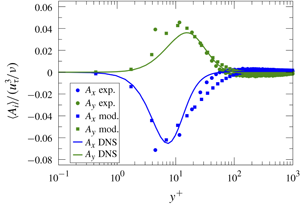Published online by Cambridge University Press: 14 April 2020

The Lagrangian approach is natural for studying issues of turbulent dispersion and mixing. We propose in this work a general Lagrangian stochastic model for inhomogeneous turbulent flows, using velocity and acceleration as dynamical variables. The model takes the form of a diffusion process, and the coefficients of the model are determined via Kolmogorov theory and the requirement of consistency with velocity-based models. We show that this model generalises both the acceleration-based models for homogeneous flows as well as velocity-based generalised Langevin models. The resulting closed model is applied to a channel flow at high Reynolds number, and compared to experiments as well as direct numerical simulations. A hybrid approach coupling the stochastic model with a Reynolds-averaged Navier–Stokes model is used to obtain a self-consistent model, as is commonly used in probability density function methods. Results highlight that most of the acceleration features are well represented, notably the anisotropy between streamwise and wall-normal components and the strong intermittency. These results are valuable, since the model improves on velocity-based models for boundary layers while remaining relatively simple. Our model also sheds some light on the statistical mechanisms at play in the near-wall region.